[English] 日本語
 Yorodumi
Yorodumi- PDB-7vgx: Neuropeptide Y Y1 Receptor (NPY1R) in Complex with G Protein and ... -
+ Open data
Open data
- Basic information
Basic information
| Entry | Database: PDB / ID: 7vgx | |||||||||
|---|---|---|---|---|---|---|---|---|---|---|
| Title | Neuropeptide Y Y1 Receptor (NPY1R) in Complex with G Protein and its endogeneous Peptide-Agonist Neuropeptide Y (NPY) | |||||||||
 Components Components |
| |||||||||
 Keywords Keywords | MEMBRANE PROTEIN / NPY / GPCR / G-protein / Complex | |||||||||
| Function / homology |  Function and homology information Function and homology informationpancreatic polypeptide receptor activity / regulation of nerve growth factor production / peptide YY receptor activity / short-day photoperiodism / negative regulation of acute inflammatory response to antigenic stimulus / neuropeptide Y receptor activity / monocyte activation / positive regulation of dopamine metabolic process / : / positive regulation of appetite ...pancreatic polypeptide receptor activity / regulation of nerve growth factor production / peptide YY receptor activity / short-day photoperiodism / negative regulation of acute inflammatory response to antigenic stimulus / neuropeptide Y receptor activity / monocyte activation / positive regulation of dopamine metabolic process / : / positive regulation of appetite / neuropeptide Y receptor binding / intestinal epithelial cell differentiation / positive regulation of eating behavior / synaptic signaling via neuropeptide / adult feeding behavior / neuropeptide receptor activity / regulation of presynaptic cytosolic calcium ion concentration / neuropeptide hormone activity / feeding behavior / neuropeptide binding / positive regulation of cell-substrate adhesion / regulation of synaptic vesicle exocytosis / central nervous system neuron development / outflow tract morphogenesis / regulation of multicellular organism growth / G protein-coupled receptor signaling pathway, coupled to cyclic nucleotide second messenger / neuropeptide signaling pathway / FOXO-mediated transcription of oxidative stress, metabolic and neuronal genes / neuronal dense core vesicle / adenylate cyclase inhibitor activity / positive regulation of protein localization to cell cortex / negative regulation of blood pressure / T cell migration / Adenylate cyclase inhibitory pathway / D2 dopamine receptor binding / response to prostaglandin E / adenylate cyclase regulator activity / G protein-coupled serotonin receptor binding / adenylate cyclase-inhibiting serotonin receptor signaling pathway / sensory perception of pain / cellular response to forskolin / regulation of mitotic spindle organization / Peptide ligand-binding receptors / calcium channel regulator activity / Regulation of insulin secretion / locomotory behavior / positive regulation of cholesterol biosynthetic process / negative regulation of insulin secretion / G protein-coupled receptor binding / G protein-coupled receptor activity / response to peptide hormone / adenylate cyclase-inhibiting G protein-coupled receptor signaling pathway / cerebral cortex development / GABA-ergic synapse / adenylate cyclase-modulating G protein-coupled receptor signaling pathway / regulation of blood pressure / centriolar satellite / G-protein beta/gamma-subunit complex binding / Olfactory Signaling Pathway / Activation of the phototransduction cascade / glucose metabolic process / G beta:gamma signalling through PLC beta / Presynaptic function of Kainate receptors / Thromboxane signalling through TP receptor / G protein-coupled acetylcholine receptor signaling pathway / Activation of G protein gated Potassium channels / Inhibition of voltage gated Ca2+ channels via Gbeta/gamma subunits / G-protein activation / neuron projection development / terminal bouton / Prostacyclin signalling through prostacyclin receptor / G beta:gamma signalling through CDC42 / Glucagon signaling in metabolic regulation / G beta:gamma signalling through BTK / Synthesis, secretion, and inactivation of Glucagon-like Peptide-1 (GLP-1) / ADP signalling through P2Y purinoceptor 12 / photoreceptor disc membrane / Sensory perception of sweet, bitter, and umami (glutamate) taste / Glucagon-type ligand receptors / Adrenaline,noradrenaline inhibits insulin secretion / Vasopressin regulates renal water homeostasis via Aquaporins / GDP binding / Glucagon-like Peptide-1 (GLP1) regulates insulin secretion / G alpha (z) signalling events / cellular response to catecholamine stimulus / ADORA2B mediated anti-inflammatory cytokines production / ADP signalling through P2Y purinoceptor 1 / G beta:gamma signalling through PI3Kgamma / adenylate cyclase-activating dopamine receptor signaling pathway / Cooperation of PDCL (PhLP1) and TRiC/CCT in G-protein beta folding / GPER1 signaling / Inactivation, recovery and regulation of the phototransduction cascade / cellular response to prostaglandin E stimulus / G-protein beta-subunit binding / heterotrimeric G-protein complex / G alpha (12/13) signalling events / sensory perception of taste / extracellular vesicle / signaling receptor complex adaptor activity / Thrombin signalling through proteinase activated receptors (PARs) Similarity search - Function | |||||||||
| Biological species |  Homo sapiens (human) Homo sapiens (human) | |||||||||
| Method | ELECTRON MICROSCOPY / single particle reconstruction / cryo EM / Resolution: 3.2 Å | |||||||||
 Authors Authors | Park, C. / Kim, J. / Jeong, H. / Kang, H. / Bang, I. / Choi, H.-J. | |||||||||
| Funding support |  Korea, Republic Of, 2items Korea, Republic Of, 2items
| |||||||||
 Citation Citation |  Journal: Nat Commun / Year: 2022 Journal: Nat Commun / Year: 2022Title: Structural basis of neuropeptide Y signaling through Y1 receptor. Authors: Chaehee Park / Jinuk Kim / Seung-Bum Ko / Yeol Kyo Choi / Hyeongseop Jeong / Hyeonuk Woo / Hyunook Kang / Injin Bang / Sang Ah Kim / Tae-Young Yoon / Chaok Seok / Wonpil Im / Hee-Jung Choi /   Abstract: Neuropeptide Y (NPY) is highly abundant in the brain and involved in various physiological processes related to food intake and anxiety, as well as human diseases such as obesity and cancer. However, ...Neuropeptide Y (NPY) is highly abundant in the brain and involved in various physiological processes related to food intake and anxiety, as well as human diseases such as obesity and cancer. However, the molecular details of the interactions between NPY and its receptors are poorly understood. Here, we report a cryo-electron microscopy structure of the NPY-bound neuropeptide Y1 receptor (YR) in complex with G protein. The NPY C-terminal segment forming the extended conformation binds deep into the YR transmembrane core, where the amidated C-terminal residue Y36 of NPY is located at the base of the ligand-binding pocket. Furthermore, the helical region and two N-terminal residues of NPY interact with YR extracellular loops, contributing to the high affinity of NPY for YR. The structural analysis of NPY-bound YR and mutagenesis studies provide molecular insights into the activation mechanism of YR upon NPY binding. | |||||||||
| History |
|
- Structure visualization
Structure visualization
| Movie |
 Movie viewer Movie viewer |
|---|---|
| Structure viewer | Molecule:  Molmil Molmil Jmol/JSmol Jmol/JSmol |
- Downloads & links
Downloads & links
- Download
Download
| PDBx/mmCIF format |  7vgx.cif.gz 7vgx.cif.gz | 234.6 KB | Display |  PDBx/mmCIF format PDBx/mmCIF format |
|---|---|---|---|---|
| PDB format |  pdb7vgx.ent.gz pdb7vgx.ent.gz | 184.6 KB | Display |  PDB format PDB format |
| PDBx/mmJSON format |  7vgx.json.gz 7vgx.json.gz | Tree view |  PDBx/mmJSON format PDBx/mmJSON format | |
| Others |  Other downloads Other downloads |
-Validation report
| Arichive directory |  https://data.pdbj.org/pub/pdb/validation_reports/vg/7vgx https://data.pdbj.org/pub/pdb/validation_reports/vg/7vgx ftp://data.pdbj.org/pub/pdb/validation_reports/vg/7vgx ftp://data.pdbj.org/pub/pdb/validation_reports/vg/7vgx | HTTPS FTP |
|---|
-Related structure data
| Related structure data |  31979MC M: map data used to model this data C: citing same article ( |
|---|---|
| Similar structure data |
- Links
Links
- Assembly
Assembly
| Deposited unit | 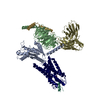
|
|---|---|
| 1 |
|
- Components
Components
-Neuropeptide ... , 2 types, 2 molecules RL
| #1: Protein | Mass: 46489.961 Da / Num. of mol.: 1 Source method: isolated from a genetically manipulated source Source: (gene. exp.)  Homo sapiens (human) / Gene: NPY1R, NPYR, NPYY1 / Cell line (production host): Sf9 / Production host: Homo sapiens (human) / Gene: NPY1R, NPYR, NPYY1 / Cell line (production host): Sf9 / Production host:  |
|---|---|
| #2: Protein/peptide | Mass: 4277.735 Da / Num. of mol.: 1 / Source method: obtained synthetically / Source: (synth.)  Homo sapiens (human) / References: UniProt: P01303 Homo sapiens (human) / References: UniProt: P01303 |
-Guanine nucleotide-binding protein ... , 3 types, 3 molecules ABG
| #3: Protein | Mass: 40427.969 Da / Num. of mol.: 1 Source method: isolated from a genetically manipulated source Source: (gene. exp.)  Homo sapiens (human) / Gene: GNAI1 / Production host: Homo sapiens (human) / Gene: GNAI1 / Production host:  |
|---|---|
| #4: Protein | Mass: 37728.152 Da / Num. of mol.: 1 Source method: isolated from a genetically manipulated source Source: (gene. exp.)  Homo sapiens (human) / Gene: GNB1 / Cell line (production host): Sf9 / Production host: Homo sapiens (human) / Gene: GNB1 / Cell line (production host): Sf9 / Production host:  |
| #5: Protein | Mass: 7845.078 Da / Num. of mol.: 1 / Mutation: C68S Source method: isolated from a genetically manipulated source Source: (gene. exp.)  Homo sapiens (human) / Gene: GNG2 / Production host: Homo sapiens (human) / Gene: GNG2 / Production host:  |
-Antibody , 1 types, 1 molecules S
| #6: Antibody | Mass: 27784.896 Da / Num. of mol.: 1 Source method: isolated from a genetically manipulated source Source: (gene. exp.)   Trichoplusia ni (cabbage looper) Trichoplusia ni (cabbage looper) |
|---|
-Details
| Has ligand of interest | Y |
|---|---|
| Sequence details | Last 11 residues (AAAHHHHHHH |
-Experimental details
-Experiment
| Experiment | Method: ELECTRON MICROSCOPY |
|---|---|
| EM experiment | Aggregation state: PARTICLE / 3D reconstruction method: single particle reconstruction |
- Sample preparation
Sample preparation
| Component |
| ||||||||||||||||||||||||||||||||||||
|---|---|---|---|---|---|---|---|---|---|---|---|---|---|---|---|---|---|---|---|---|---|---|---|---|---|---|---|---|---|---|---|---|---|---|---|---|---|
| Molecular weight | Value: 0.16 MDa / Experimental value: NO | ||||||||||||||||||||||||||||||||||||
| Source (natural) |
| ||||||||||||||||||||||||||||||||||||
| Source (recombinant) |
| ||||||||||||||||||||||||||||||||||||
| Buffer solution | pH: 8 | ||||||||||||||||||||||||||||||||||||
| Buffer component |
| ||||||||||||||||||||||||||||||||||||
| Specimen | Conc.: 10 mg/ml / Embedding applied: NO / Shadowing applied: NO / Staining applied: NO / Vitrification applied: YES | ||||||||||||||||||||||||||||||||||||
| Specimen support | Grid material: COPPER / Grid mesh size: 300 divisions/in. / Grid type: Quantifoil R1.2/1.3 | ||||||||||||||||||||||||||||||||||||
| Vitrification | Instrument: FEI VITROBOT MARK IV / Cryogen name: ETHANE / Humidity: 100 % / Chamber temperature: 285 K / Details: blot for 5 seconds before plunging |
- Electron microscopy imaging
Electron microscopy imaging
| Experimental equipment |  Model: Titan Krios / Image courtesy: FEI Company |
|---|---|
| Microscopy | Model: FEI TITAN KRIOS |
| Electron gun | Electron source:  FIELD EMISSION GUN / Accelerating voltage: 300 kV / Illumination mode: FLOOD BEAM FIELD EMISSION GUN / Accelerating voltage: 300 kV / Illumination mode: FLOOD BEAM |
| Electron lens | Mode: BRIGHT FIELD / Nominal magnification: 75000 X / Nominal defocus max: 3750 nm / Nominal defocus min: 1250 nm / Cs: 0.1 mm |
| Specimen holder | Cryogen: NITROGEN |
| Image recording | Electron dose: 40 e/Å2 / Detector mode: COUNTING / Film or detector model: FEI FALCON III (4k x 4k) |
| EM imaging optics | Spherical aberration corrector: Microscope was modified with a Cs corrector |
| Image scans | Width: 4096 / Height: 4096 |
- Processing
Processing
| Software |
| ||||||||||||||||||||||||||||||||
|---|---|---|---|---|---|---|---|---|---|---|---|---|---|---|---|---|---|---|---|---|---|---|---|---|---|---|---|---|---|---|---|---|---|
| EM software |
| ||||||||||||||||||||||||||||||||
| CTF correction | Type: PHASE FLIPPING AND AMPLITUDE CORRECTION | ||||||||||||||||||||||||||||||||
| Particle selection | Num. of particles selected: 1339224 | ||||||||||||||||||||||||||||||||
| Symmetry | Point symmetry: C1 (asymmetric) | ||||||||||||||||||||||||||||||||
| 3D reconstruction | Resolution: 3.2 Å / Resolution method: FSC 0.143 CUT-OFF / Num. of particles: 233117 / Symmetry type: POINT | ||||||||||||||||||||||||||||||||
| Atomic model building | Protocol: RIGID BODY FIT / Space: REAL | ||||||||||||||||||||||||||||||||
| Atomic model building |
| ||||||||||||||||||||||||||||||||
| Refinement | Cross valid method: NONE Stereochemistry target values: GeoStd + Monomer Library + CDL v1.2 | ||||||||||||||||||||||||||||||||
| Displacement parameters | Biso mean: 71.54 Å2 | ||||||||||||||||||||||||||||||||
| Refine LS restraints |
|
 Movie
Movie Controller
Controller


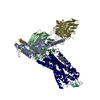

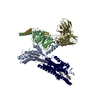

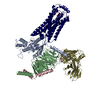
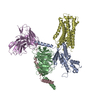
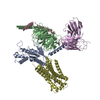

 PDBj
PDBj




































